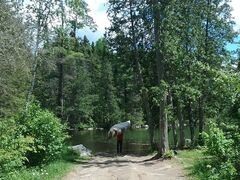 Clean Drain Dry applies to canoes and kayaks too. Photo credit: L. Anderson, Lake County SWCDAquatic invasive species (AIS) such as spiny waterflea and Eurasian watermilfoil can hitch a ride on canoes, kayaks, and equipment just as they can on other forms of watercraft. And while on longer trips, many canoeists and kayakers are likely to engage in the risky behavior of visiting multiple lakes in one day. Studies have shown that some species could indeed survive the journey across a portage, and a report by Quetico Provincial Park provides evidence that spiny waterflea were likely introduced to three remote lakes by human means: either by watercraft or other equipment.
Clean Drain Dry applies to canoes and kayaks too. Photo credit: L. Anderson, Lake County SWCDAquatic invasive species (AIS) such as spiny waterflea and Eurasian watermilfoil can hitch a ride on canoes, kayaks, and equipment just as they can on other forms of watercraft. And while on longer trips, many canoeists and kayakers are likely to engage in the risky behavior of visiting multiple lakes in one day. Studies have shown that some species could indeed survive the journey across a portage, and a report by Quetico Provincial Park provides evidence that spiny waterflea were likely introduced to three remote lakes by human means: either by watercraft or other equipment.
The good news is it’s easy to take action to prevent AIS from being transported on non-motorized watercraft. With fewer compartments and nooks and crannies, it’s easy to reach everywhere on the boat when you Clean, Drain, and Dry. If you lift your boat out while it’s still floating in the water, plants are less likely to get stuck to the hull. Remove any plants and mud from the watercraft, drain the water and remove any residual water with a rag. If you’re able, dry the watercraft as best you can before you bring it to the next waterbody.
And don’t forget your other equipment! Fishing gear can be risky because it may snag plants and spiny waterflea. Make sure you check your line to ensure that there’s nothing hitching a ride. If you are fishing with live bait, the best practice is to drain any water on shore and replace it with enough bottled, filtered, tap, or boiled water for the bait to survive to the next lake.
By taking these simple steps every time you canoe or kayak you are helping to preserve some of what makes the non-motorized experience so special. Here's a great quick video on the topic:
